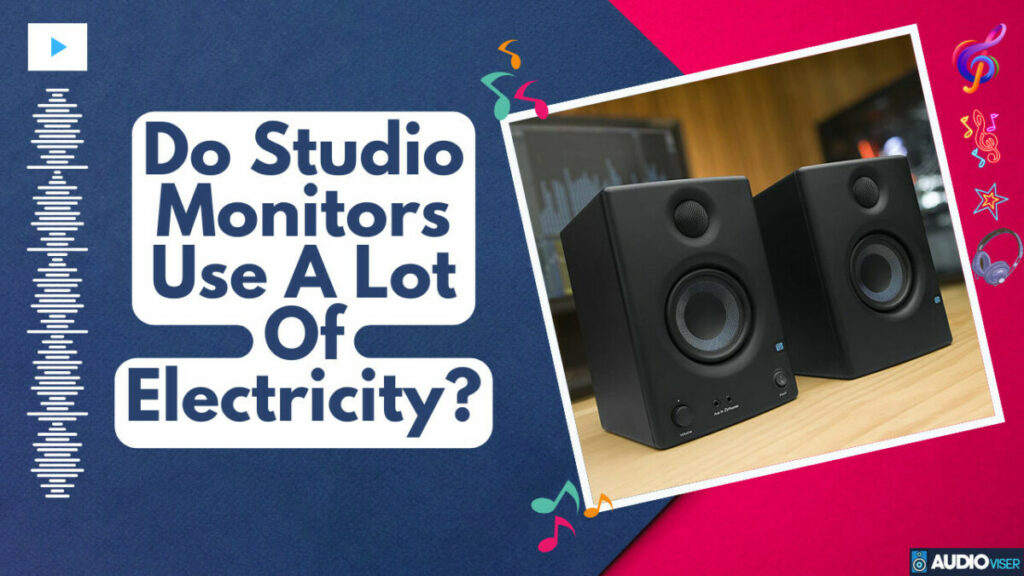Curious about the electricity your studio monitors are pulling? You’re not the only one. It’s pretty vital to get a handle on the power draw of your equipment, not just for keeping your bills in check, but also for doing your bit for the planet.
In this piece, we’re going to break down just how much juice your studio monitors are sipping, what can cause that to vary, and how to go about choosing models that are a bit more easy on the energy.
Plus, we’ll throw in some handy hints on how to dial back your studio’s power consumption. So, let’s power up and get clued in on the effect your studio monitors have on your electricity bills.
How Much Electricity Do Studio Monitors Use?
Studio monitors are definitely not the energy monsters of your household devices. How much juice they suck up, though, boils down to their power rating and how much you crank up the volume.
For example, a 50-watt rated monitor, when used at the same volume, usually sips less power compared to a 200-watt one. The golden rule here is, the lower the volume, the less energy these bad boys need; crank up the volume and the energy need rises, too.
But even when you’re blasting those tunes, most studio monitors won’t hit their max wattage. If you’re a stickler for exact power usage numbers though, you gotta eyeball the specs of your specific monitor. Better yet, whip out a power meter to clock the power draw of your device in real-time.
Power Consumption of Studio Monitors
Ever thought about how much juice your studio monitors are sucking up? Let’s break it down. Power consumption of your monitors isn’t just a random number, it’s tied directly to their lifespan and the quality of sound they’re kicking out. On average, we’re looking at about 10 to 100 watts per channel, but don’t quote me on that because it can swing either way depending on the model and how loud you’re cranking it.
Now, here’s the kicker: more juice equals more wear and tear. So, the more power you’re pumping through those bad boys, the quicker they’re gonna give up the ghost. But before you go thinking you can just dial down the volume to save on electricity, hold up. The volume’s got a direct impact on the sound quality. Dial it down too low and you’re gonna lose some of that sweet sweet audio fidelity.
So, what’s the solution? It’s all about striking that perfect balance between power consumption, monitor longevity, and maintaining killer sound quality. Managing your studio monitors isn’t just about keeping them alive, it’s about squeezing every last drop of performance out of them while they’re still kicking.
Factors That Influence the Electricity Usage of Studio Monitors
When it comes to the power consumption of your sound gear, there are a few key things to keep in mind.
- Firstly, consider the age of your studio monitor. Just like us, as they get older, they start slowing down a bit. This means they’ll need more juice to keep delivering that sweet sound you love.
- Secondly, there’s this cool feature on some studio monitors called ‘standby mode’. It’s kind of like the monitor’s nap time. So, when you’re not working on your next masterpiece, the monitor chills out, cutting down on its energy use.
- Thirdly, think about how much you’re using your equipment. It’s pretty straightforward: the more you use it, the more power it’s going to eat up.
- And lastly, volume. The louder you go, the more power you’re going to need. So, if you’re one of those who love to blast your tunes, be prepared for a higher electric bill.
Getting a grip on these factors can help you manage your electricity usage better, and give your monitor a longer, happier life. It’s like hitting two birds with one stone. So, it’s definitely worth keeping these in mind!
Comparing the Energy Efficiency of Different Studio Monitors
When you start sizing up the energy efficiency of various audio gear, you’ll really get a feel for how much dough you could be saving or squandering. When you stack up different types of monitors, you’ll see that the active studio monitors are the real MVPs when it comes to energy efficiency. This is all thanks to their slick built-in amplifiers that keep a tight grip on power consumption.
On the flip side, passive monitors lean on external amps which, let’s be real, can be energy hogs. The stakes get even higher when you consider the environmental angle. Gear that sucks up more power also pumps out more carbon emissions. So, going for energy-efficient studio monitors is like hitting two birds with one stone – you’re keeping your bills in check and doing your bit for Mother Earth at the same time.
How to Reduce the Electricity Use of Your Studio Monitors
Alright, so you’re on the hunt for a more eco-friendly studio and looking for some clever ways to dial down on the juice your equipment is chugging? Here are a few tricks you might find handy:
- Monitor Placement: You know what? Where you place your studio monitors can really make a difference when it comes to their efficiency. Sidestep placing them in corners where sound can get a boost and lead to an unneeded uptick in power consumption.
- Power Saving Features: A lot of today’s monitors are equipped with these nifty power-saving modes. Make sure you’re not ignoring them and squeeze out every bit of potential they got.
- Turn Off When Not in Use: This one’s a no-brainer. If you’re not using your gear, switch it off. Standby mode? Not as innocent as it seems, it’s still sipping on electricity.
- Regular Maintenance: Keep your monitors spick and span. Dust can play the villain here by causing the system to overheat, which only ups the power usage.
Keep in mind, every bit of energy you save is a step towards a more sustainable studio. So, let’s do our bit, shall we?
Does The Break-In Period Use A Lot Of Electricity?
Just like a pair of fresh kicks need some breaking in, studio monitors could also use some get-to-know-you time to really hit their performance stride. Now, some might argue it’s a bit overrated, but others swear that giving new speakers a break-in period can really dial up their tonal balance and sound quality.
Here’s the logic: during this break-in phase, the insides of your monitors take the time to adjust and settle into place. The result? Better audio accuracy and a more responsive sound field. This usually uses less electricity, because your studio monitors will need to run at half volume.
Long story short, don’t shrug off the potential perks of spending some quality time to break-in your studio monitors if you’re all about maxing out their performance. It’s like getting comfy with a new friend.
The Impact of Studio Monitors on Your Electricity Bills
Noticed your electricity bills going through the roof lately? Well, your music gear might just be the sneaky little devil causing all the drama. Believe it or not, those studio monitors, small as they may seem, can be total energy hogs.
The juice they suck up largely depends on how robust they are. When I say robust, I mean how long they can keep belting out those beats without their performance taking a nosedive. The tougher the monitor, the more energy-efficient it tends to be, so it might just save you a few bucks on your electricity bill.
You also got to get your head around energy rules and regs. These can include standards on energy use and even the occasional cashback offer or bonus for using green tech. By picking studio monitors that play by these energy-saving rules, you’re not just getting top-notch performance, but also putting a lid on your power expenses.
Pretty neat, right?
Composer & Audio Engineer
I’m a composer and audio engineer crafting sonic magic. Combining my skills in rhythm, harmony, and sound synthesis to create the ultimate auditory experience.









